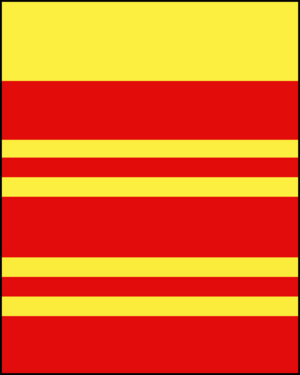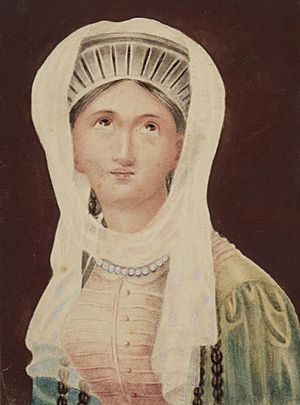Constance, Duchess of Brittany facts for kids
Quick facts for kids Constance |
|
|---|---|
| Duchess of Brittany | |
| Reign | 1166–1201 |
| Predecessor | Conan IV |
| Successor | Arthur I |
| Co-rulers | Geoffrey II (1181-1186) Arthur I (1196-1201) Guy of Thouars (1199-1201) |
| Born | circa 1161 |
| Died | circa 5 September 1201 Nantes |
| Burial | Villeneuve Abbey, Nantes |
| Spouse | Geoffrey II (m. 1181; dec. 1186) Ranulph de Blondeville, Earl of Chester (m. 1188; ann. 1198) Guy of Thouars (m. 1199) |
| Issue | Eleanor, Fair Maid of Brittany Matilda of Brittany Arthur I, Duke of Brittany Alix, Duchess of Brittany Catherine of Thouars |
| House | Penthièvre |
| Father | Conan IV, Duke of Brittany |
| Mother | Margaret of Huntingdon |
| Religion | Roman Catholicism |
Constance (in Breton: Konstanza; born around 1161, died around September 5, 1201) was a powerful ruler. She was the Duchess of Brittany from 1166 until her death in 1201. She was also the Countess of Richmond from 1171 to 1201. Constance was the daughter of Duke Conan IV. Her mother was Margaret of Huntingdon. Margaret was the sister of two Scottish kings, Malcolm IV and William I.
Contents
Life as a Duchess
Constance's father, Conan IV, had worked hard to bring the Duchy of Brittany back together. He fought wars against Henry II of England to do this. After these wars, Conan IV faced new problems. Some of the noble families in Brittany rebelled against him. He asked Henry II of England for help to stop these rebellions.
Becoming Duchess of Brittany
In 1166, King Henry II of England invaded Brittany. He wanted to punish the rebellious nobles. To gain more control over Brittany, he forced Duke Conan IV to step down. This meant Conan gave up his title and power. He had to give it to his five-year-old daughter, Constance. Henry II also arranged for Constance to marry his son, Geoffrey. So, at just five years old, Constance became the Duchess of Brittany.
She spent her childhood living at the English royal court. This was a common practice for young nobles at the time.
Inheriting Richmond
In February 1171, Constance's father, Conan IV, passed away. Constance was the rightful heir to the Earldom of Richmond. However, she did not officially take control of this land until 1183 or 1184.
First Marriage and Widowhood
In 1181, when Constance was about 20 years old, she was forced to marry Geoffrey. This marriage had been planned since she was a child. On August 19, 1186, Geoffrey died in a tragic accident. He was trampled by a horse during a tournament in Paris. After his death, Constance became the true ruler of Brittany.
Second Marriage and Imprisonment
On February 3, 1188, King Henry II of England arranged another marriage for Constance. She married Ranulf de Blondeville, 6th Earl of Chester. He was one of the most powerful earls in England. Ranulf sometimes called himself the Duke of Brittany. But he never truly controlled the duchy. The people of Brittany, and Constance herself, never accepted him as their duke. They kept him out of the government.
After King Richard I became the English king, he became more involved in Brittany. He kept Constance's daughter, Eleanor, with him. This might have been a condition for Constance to continue ruling Brittany. In 1190, Constance visited Richard's court in Tours.
In 1191, Richard officially named Constance's son, Arthur, as his heir. This was part of a treaty signed with Philip II of France.
Fighting for Her Son's Rights
To help her son Arthur become more powerful, Constance made him a co-ruler of Brittany in 1196. This upset King Richard. He called Constance to Bayeux. Then, Ranulf kidnapped her in Pontorson and imprisoned her in Saint-James de Beuvron. Richard spread rumors that Constance was imprisoned for marriage reasons. But the people of Brittany rebelled to support her. Arthur was sent to Brest for safety.
Richard demanded that the Bretons give him hostages in exchange for Constance's freedom. The Bretons agreed, but Constance and the hostages remained imprisoned. The rebellions continued. Finally, Richard gave in to the pressure and released Constance in 1198. Once back in Brittany, Constance had her marriage to Ranulf officially ended.
Later Years and Third Marriage
On June 1, 1199, Pope Innocent III made a decision about the church in Brittany. He decided that the Archbishopric of Dol should be under the Metropolitan of Tours. This meant the archbishop lost his title. Constance disagreed with this decision. She felt it gave an advantage to Philip Augustus over Brittany. Because of her disagreement, she was removed from the church (excommunicated).
Constance married Guy of Thouars in September or October 1199.
Between 1198 and her death, Constance ruled Brittany with her son Arthur. During these years, Constance advised Arthur to form an alliance with France. This was the same policy her late husband Geoffrey II had followed. At Constance's request, her daughter Eleanor was released from royal custody. Eleanor then joined Constance and Arthur in France.
Constance's Family
When Constance was a girl, she would not have inherited the duchy if she had a brother. Some old records suggest that Constance's parents, Margaret and Conan, had more than one child. Two documents from Constance and her son Arthur around 1200 mention a brother of Constance named William. If William was a boy, he should have inherited the duchy after Conan. Some historians believe that King Henry II forced Conan to step down in 1166 to prevent any son of the Duke from inheriting the duchy.
Constance and Geoffrey had three children:
- Eleanor, Fair Maid of Brittany (born between 1182 and 1184, died 1241)
- Matilda (born around 1185, died before 1189)
- Arthur I, Duke of Brittany (born 1187, died 1203) - He was born after his father Geoffrey died.
Constance and Guy had two daughters:
- Alix of Thouars (born 1200, died 1221). She married Peter Mauclerc. He was the first ruler of Brittany from the House of Dreux.
- Catherine of Thouars (born 1201, died around 1240). She was known as Dame of Vitre. She married Andrew III, Baron of Vitré. Andrew was famous for rebuilding the Château de Vitré.
Some historical records suggest that Constance might have had a third daughter with Guy:
- Margaret of Thouars (born 1201, died between 1216 and 1220). She was the first wife of Geoffrey, Viscount of Rohan.
Death and Burial
Constance passed away at the age of 40 on September 5, 1201, in Nantes. She was buried at Villeneuve Abbey near Nantes. She had helped establish this abbey earlier that same year.
The exact reason for Constance's death is debated. One old record said she died from leprosy, but this is likely not true. It is also believed that she died from health problems after giving birth to twin daughters.
Constance in Stories and Plays
In Books
Constance of Brittany appears in many books and plays, including:
- The Troublesome Reign of King John (around 1589), an old play by an unknown writer.
- King John (1593-1596), a famous play by William Shakespeare.
- Jean sans Terre ou la mort d’Arthur (1791) by Jean-François Ducis.
- King John (1800) by Richard Valpy.
- La Mort d’Arthur de Bretagne (1826), a poem by Alexis Fossé.
- Novels by Sharon Kay Penman: Prince of Darkness (2005), Devil's Brood (2008), Lionheart (2011), and A King's Ransom (2014).
Constance is also mentioned in other works like the poem Le petit Arthur de Bretagne à la tour de Rouen (1822) by Marceline Desbordes-Valmore. She appears in the play Arthur de Bretagne (1885) by Louis Tiercelin. She is also in novels such as Le Loup blanc (1843) by Paul Féval and Le Poids d’une couronne (légende bretonne) (1867-1868) by Gabrielle d’Étampes. More recently, she is in the second book of the trilogy Le Château des Poulfenc (2009) by Brigitte Coppin. She and her daughters Matilda, Alix, and Catherine, along with her third husband Guy of Thouars, are in the novel Dans l’Ombre du Passé (2020) by Léa Chaillou.
In Theatre and TV
Constance is a character in William Shakespeare's play King John. In this play, she has several powerful speeches about sadness and death. On screen, she has been played by:
- Julia Neilson in the silent short film King John (1899).
- Sonia Dresdel in the BBC Sunday Night Theatre version (1952).
- Claire Bloom in the BBC Shakespeare version (1984).
- In the ITC series The Adventures of Robin Hood, she was played by Dorothy Alison (in seasons 1 and 2), Pamela Alan (season 3), and Patricia Marmont (season 4).
- She was also played by Paula Williams (as a girl) and Nina Francis (as an adult) in the BBC TV drama series The Devil's Crown (1978).
See also
 In Spanish: Constanza de Bretaña para niños
In Spanish: Constanza de Bretaña para niños



